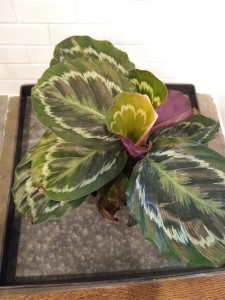The scenario goes something like this…A child wants a dog. All his friends have dogs and he is the only one without a dog. The child’s busy parents, wary of another long term commitment won’t agree to get a dog. The child chips away at the parents’ resistance until they finally give in—as long as the child will be responsible for feeding and walking the dog.
A month later the neighbors notice that one or both of the parents have taken over most of the dog walking.
 My daughter never wanted a dog; she wanted tropical plants. I admire many tropical plants, but prefer to admire them in shops, botanical gardens and the homes of friends with south-facing windows and warm, humid plant rooms. Back when my daughter lived at home, we enacted the “dog scenario” many times with alluring tropicals and I always ended up watering and caring for the m. Now, it has happened again.
My daughter never wanted a dog; she wanted tropical plants. I admire many tropical plants, but prefer to admire them in shops, botanical gardens and the homes of friends with south-facing windows and warm, humid plant rooms. Back when my daughter lived at home, we enacted the “dog scenario” many times with alluring tropicals and I always ended up watering and caring for the m. Now, it has happened again.
My daughter wanted a statement plant for her new apartment. She picked a large, showy prayer plant or Maranta leukoneura var. erythroneura. Fresh from the nursery, it bore a mound of big, paddle-shaped leaves that hovered about eight inches above the top of the pot. They were breathtaking—each one was dark green edged in a lighter shade, with a row of light green chevrons down the mid-rib, which also radiated rows of thin, red horizontal stripes. We bought a suitably dramatic tall pot and brought plant and pot back to my house to lodge until my daughter got finished furnishing her apartment.
Now, eight weeks later, my plant lodger has become a foster plant. What is worse, it has become an ailing foster plant. Many of the leaves have curled up and died and the remaining few look as if they might be going in that direction.
How did this happen? Probably overwatering and inattention, seasoned with a soupcon of resentment at having an unwanted tropical in my kitchen.
Last weekend, I finally faced reality. If I did nothing, the plant would die and I would have to replace it with another. I would also have to explain it to my daughter, who happened to mention it in a phone call.
So, I went back to the drawing board, via the internet, and figured out where it had all gone wrong. Prayer plants need well-drained potting mix and bright indirect indoor light. My foster plant had those things, residing comfortably in an east-facing window. It was getting regular water, as well.
The bad news was that I had overwatered. In the fall and winter, prayer plants and other tropicals need very little water, as growth slows to a near standstill. In spring, as the hours of daylight lengthen, the plants begin active growth and their water needs increase. My daughter’s prayer plant was drowning, and, in fact, when I lifted it out of the tall pot, excess water dripped on the floor.
It was not my finest horticultural hour.
Fortunately the plant still had four fairly healthy leaves. I cut off all the dead leaves and repotted the newly-trimmed specimen. In the week since, I have looked at it every day, but have not watered. I’ll give it a bit of water over the weekend.
The early news is good. The four survivor leaves have perked up and I see a new one about to unfurl. While I don’t anticipate a return to lushness until next April or May, I have high hopes that the plant will survive until that time.
The question remains—What do I tell my daughter when she announces that she is coming to pick up her lovely accent plant? I could lay the cards on the table and tell her the truth, or I could lie and explain that the plant was obviously diseased when it came from the nursery.
I think I will split the difference and tell her that the prayer plant is in the midst of seasonal doldrums and that I will hand it over to her next spring when it is better. In the meantime, I will offer her the original tall pot filled with rooted cuttings of purple-leafed spider lily or Tradescantia pallida ‘Purpurea’, which is beautiful, dramatic and tough as nails. She likes tradescantia, so chances are the strategy will work.
In the coming weeks and months, while I fuss over the holiday amaryllis, the post-holiday paperwhites and the overwintering geraniums, I will keep a closer watch on my foster plant. With any luck, it will recover its former good looks by next spring. I will then deliver it to my daughter’s apartment with a flourish. Having atoned for my horticultural sins and facilitated a prayer plant resurrection, I will then be entitled to a small sigh of relief.
